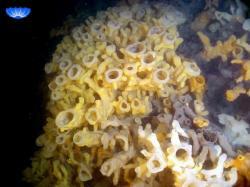
|
| ©University of Victoria |
| Glass sponges are up to 50 centimetres high, and can build reefs up to 450 cm tall. |
Furthermore, unlike the other known glass sponge reefs in Canada, the US reefs appear to be fuelled by methane.
Paul Johnson, of the University of Washington, US, led the expedition that discovered the reefs on 10 June off the coast of Washington state. He says they are oases of marine life, several hundred feet across, and surrounded by uninhabited expanses of seafloor.
The reefs are teaming with sardines, crabs, prawns, rockfish and zooplankton, says Johnson: "It's like looking at an overcrowded aquarium in an expensive Japanese restaurant."
'Unknown ecosystem'
The team were stunned to find large amounts of methane gas seeping out of the nearby seafloor, and even more surprised to find that the reefs appear to be fuelled by the gas. Specialised bacteria consume the methane, and the sponges suck in the bacteria.
The Canadian glass reefs, though, are not fuelled by methane, and Johnson believes his team has discovered something new. "Everybody is feeding off the methane," he says. "It's a whole ecosystem that people didn't know about."
Individual glass sponges, such as the Venus' flower basket, are found in various oceans, but are a different species to the ones that form colonies to build reefs.
Shelter in the deep
Until the discovery of the Canadian example, reef-building species were thought to have been driven to extinction 100 million years ago by competition from newly arrived diatoms.
Like glass sponges, these single-celled algae also use silica dissolved in seawater to build their shells. However, the newly discovered US reefs are nearly 200 metres below the surface - too deep for diatoms, which need natural light to survive.
The discovery of glass sponge reefs in the sheltered waters of the Canadian Georgia and Hecata straits in 1991 led scientists to believe that reef-building glass sponges could only survive in benign ecological niches to survive. But the US reefs are in open water, exposed to rough winter storms, suggesting other glass sponge reefs may exist elsewhere.
Watch three short videos of the Canadian glass sponge reefs here, here and here.



Reader Comments
to our Newsletter